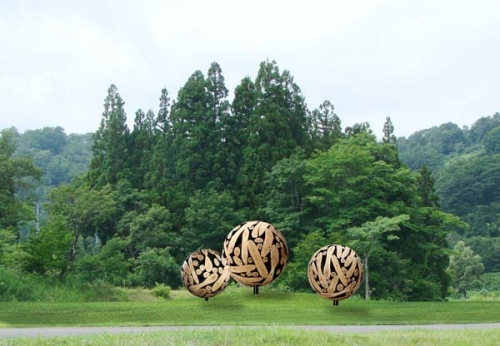7.26–9.13
Echigo-Tsumari region (Tokamachi City and Tsunan Town, Niigata Prefecture)
http://www.echigo-tsumari.jp/

Lee Jaehyo, 0121-1110=109061 (2009 drawing)
A conversation between town and country, contemporary art and satoyama, young and old, built up over some ten years. That it has been possible to overcome these differences in bringing people and things together comes down to the fact it is about art. “Newborn art needs to be nurtured in various ways,” says general director Kitagawa Fram. “The process of so many people providing this care seems to have brought them together again.”
The Echigo-Tsumari Ar t Triennial is an international art festival held every three years from summer through early autumn in the Echigo-Tsumari region, encompassing Tokamachi City and Tsunan Town in Niigata Prefecture. At 760 square kilometers, the region is larger than all of Tokyo’s 23 wards combined, although its population is less than 75,000 residents, 30% of whom are aged 65 years or over. For some 1500 years, rice cultivation and other forms of agriculture have been the lifeblood of the region, but with depopulation on the rise due mainly to the exodus of young people to jobs in the cities, in 2000 the triennial was launched based on the concept ‘Human beings as part of nature’ with the satoyama of Echigo-Tsumari as its stage. Each triennial attracts between 150 and 200 artists from Japan and overseas who uncover and communicate to a world audience from an art perspective the intrinsic value of the region. More than 150 works installed during previous triennials, including Ilya and Emilia Kabakov’s sculpture The Rice Field, James Turrell’s accommodation facility House of Light, and Christian Boltanski and Jean Kalman’s The Last Class, an installation that uses an entire building, still remain in place, and visitors will be able to view these along with works newly created for this year’s exhibition.
This year’s triennial, the fourth to be held, will feature around 350 works by artists from 28 countries and regions, including Antony Gormley, Janet Cardiff and George Bures Miller, Pascale Marthine Tayou, Aoki Noe, Shiota Chiharu, and Mukaiyama Tomoko. The festival has no center as such, with the works being scattered around the 200 or so hamlets that make up the community. This year, threads, or spiders, appears to be one of the keywords chosen by the artists to symbolize the universal memories of the things they felt on location.
One of the appeals of ar t festivals is the choice of exhibition ‘space’. Of particular interest in the case of this festival is the effort put into reviving abandoned houses and bringing schools back to life. According to Claude Lévêque, who visited the area in February to carry out research, “Tsumari has an appeal all of its own, which sets it apart from all the other international festivals. With all the changing of trains and driving through mountains, it’s almost as if you’re in a road movie.” This is Lévêque’s second appearance at the festival. He plans to create an installation that will draw out the collective memories that lie dormant inside one of these abandoned wooden houses and the items left in it.
Tashima Seizo, also the director of the autobiographical film Village of Dreams, will create The Picture Book and Nut Art Museum, in which an entire school will be transformed into a picture book world. Other highlights include Fukutake House, a joint initiative by seven galleries representing Japan (among them Koyama Tomio Gallery and Shugoarts), China’s Long March Space, and South Korea’s Keumsan Gallery, who have joined forces at the instigation of the festival’s general producer, Fukutake Soichiro. Today, as the nation’s birthrate continues to decline, bringing schools back to life is an issue of concern to the entire country. Several projects in which art schools and universities are using these buildings as seminar venues and art centers are also underway.
Another part of the festival’s appeal is that local residents ‘collaborate’ in the creative process. This year, residents will get the opportunity to participate in the work of many of the artists, including Antje Gummels, who plans to install a host of ‘eyes’ and ladder-like objects in a beech forest. Many of the residents are farmers who have learnt from experience how to make things, and by participating in the art-making process these residents are regaining a sense of vitality. Lee Jae-Hyo from South Korea and Guan Huaibin from China will show their work in the hamlet of Uwano in Tsunan. The two have come up with a plan for a residence, dubbed the Northeast Asia Art Hamlet, to which artists from around Northeast Asia will be invited. At the Dragon Museum of Contemporary Art, a kiln relocated from Fujien Province in China and reconstructed in the same hamlet by Cai Guo-Qiang in 2000, Jennifer Wen Ma will unveil a passageway-like installation with mirrors.
Visiting the festival involves hiking up mountains and looking deep inside oneself amidst some iconic Japanese scenery. Someone once said of this experience, “I was expecting blazing heat, but thinking back now, there was a wind blowing,” and they were right. There is something nostalgic about that wind, which seems to come from somewhere far away.
(Shirasaka Yuri)
